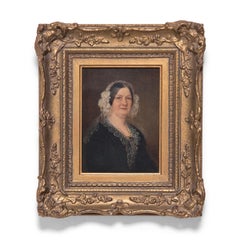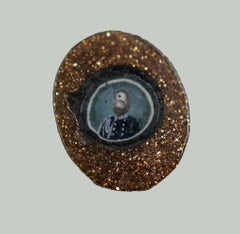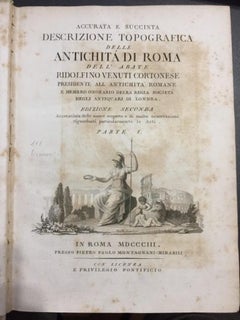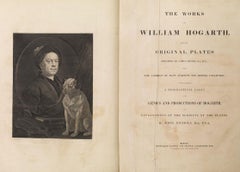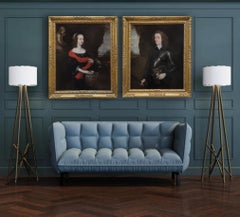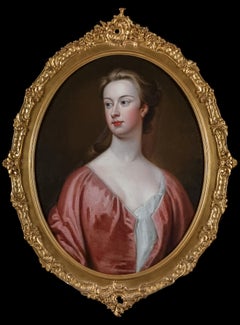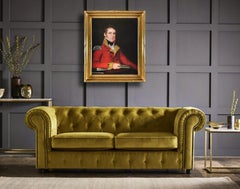19th Century More Art
to
1
4
2
3
2
1
3
1
2
Overall Height
to
Overall Width
to
156
18
6
3
2
2
2
1
1
1
1
44
6
1
13
1
2
2
2
1
1
Style: Old Masters
Period: 19th Century
Oil Portrait of a Victorian Lady, c. 1850
Located in Chicago, IL
Painted in the 19th century, this exquisite miniature portrait wonderfully exemplifies realism in traditional oil painting. The small artwork is painted in the conventional portraiture style of the Old Masters, and achieves soft realism with fine brushwork and a subdued, neutral palette. The half length portrait depicts a fine Victorian woman dressed in all black with a delicate lace collar and bonnet. She wears a ruby broach...
Category
Old Masters 19th Century More Art
Materials
Oil
Des Enfants Traînant Un Chariot Chargé de Fruits
Located in Milford, NH
A fine oil painting with cherubs and a cart of fruit by French artist Leger Cherelle (1816-1867). Cherelle was born in Versailles, France, a...
Category
Old Masters 19th Century More Art
Materials
Oil, Board
Portrait of Giuseppe Garibaldi - Original Glass Art - 19th Century
Located in Roma, IT
Portrait of Garibaldi is an admirable piece of art painted on small glass, realized by anonymous artists of the 19th Century.
Good condition.
The tiny and small piece of glass art,...
Category
Old Masters 19th Century More Art
Materials
Glass
Early 19th Century Pastel Depicting The Goddess Hebe
Located in London, GB
A fine early nineteenth century Regency Period pastel, depicting the goddess Hebe.
Pastel upon paper, housed within a period circular mounted rectangular frame.
In Greek mythology, Hebe was the goddess of...
Category
Old Masters 19th Century More Art
Materials
Pastel
Accurata e succinta descrizione topografia delle Antichità di Roma
Located in Roma, IT
Complete title: Accurata e succinta descrizione topografia delle Antichità di Roma dell'Abate Ridolfino Venuti Cortonese Presidente all'Antichità Romane e Membro Onorario della Regia...
Category
Old Masters 19th Century More Art
Materials
Paper, Etching
The Works Of William Hogarth From The Original Plates - 1820s - Old Master
Located in Roma, IT
Big In-folio Volume
Baldwin and Cradock, London
Majestic work collection most of Hogarth’s graphic production, printed from the original plates. Restored by James Heath.
The Volume ...
Category
Old Masters 19th Century More Art
Materials
Paper
Related Items
Pair (2) Portraits Gentleman & Lady, William & Rachel Helyar c.1656, Civil War
By Robert Walker
Located in London, GB
Portrait of Colonel William Helyar (1621-1698) and Rachel Helyar (c.1633-1678) c.1656
Circle of Robert Walker (act. 1637-1656)
These fascinating portraits, presented by Titan Fine Art, depict Colonel William Helyar, High Sheriff of Somersetshire, and his wife Rachel Helyar nee Wyndham, a daughter and co-heiress of Sir Hugh Wyndham, 1st Baronet (died 1663) of Pilsden Court, Dorset. They are exquisite examples of portraiture during the Interregnum when England was under various forms of republican government.
The history of the seventeenth century is in part the story of the Stewarts and their approach to government and the church; their ebbing and flowing popularity and the disastrous decisions that led to Civil War. But another fascinating dynasty also ruled Britain: the Cromwell’s. Between 1653 and 1659, following the Civil Wars and experimental Commonwealth, Oliver Cromwell governed as Lord Protector followed by his son Richard. Cromwell’s Protectorate is usually imagined as a grey, joyless, military regime. But the reality was rather different. Cromwell presided over a colourful and fashionable court where music and the arts flourished, masques were revived and the first English operas performed. Too often the London of the 1650s is painted as puritanical and repressive in contrast to the vivid, fun-loving capital of the Restoration. Yet, under Cromwell, this was the city where the first coffee houses were opening, where a young Samuel Pepys was embarking on his career as a civil servant with the patronage of one of Cromwell’s councillors and where Christopher Wren was enjoying his new Chair of astronomy at Gresham College, appointed after the personal intervention of Cromwell. When Cromwell was invested as Lord Protector for the second time in 1657, the lavish ceremony in Westminster Hall and procession through London matched any previous coronation for pageantry with thousands lining the streets, bells ringing, bonfires blazing and free French wine flowing through the city.
The gentleman in our portrait is Colonel William Helyar (1621-1698), Sheriff of Somerset and as a Royalist during the English Civil War. As one of the most prominent old families of the South-West, the Helyar’s family roots in Somerset can be traced back to 1616 when the Reverend William Helyar (1559-1645), chaplain to Elizabeth I, who was also a cousin by marriage, purchased the family residence Coker Court in East Coker, Somerset. He married a Devonshire heiress and several estates were bestowed on him as a result. He was a warm supporter of Charles I in the Civil War and was in residence at Exeter in 1643 when the Parliamentarians pillaged the cathedral. Elderly as he was, he boldly resisted them, but was beaten, pelted with mud, and locked up in a ship in the port and only let out on payment of £800. He retired to Coker where he died in 1645. His eldest son Henry died in 1634 and he was succeeded by his grandson, Colonel William Helyar, the sitter in our portrait. Colonel Helyar raised a troop of horse for King Charles I and was a colonel in the king's army. He was at Exeter when it was captured by the Parliamentary forces in 1646 and thus deemed ‘Traitor to the Parliament’. His estates were sequestered, but they were returned and he was discharged and pardoned on payment of £1,522. During the Restoration he was a Sheriff and he also helped James II repel the Monmouth Rebellion.
The companion portrait represents the Colonel’s wife, Rachel Helyar (baptised 24th June 1633 at St Mary Aldermanbury, London – died 1678). She was the youngest daughter and co-heir of Sir Hugh Wyndham, 1st Baronet of Pilsdon Court and Mary Wyndham nee Alanson (Sir Hugh should not be confused with his first cousin once removed from Somerset, also Sir Hugh Wyndham (bef. 1604 - 1684). Rachel is a thirteenth generation descendant of King Henry III.
The couple resided at the family seat of Coker Court (interestingly, within the churchyard, lie the remains of the poet T.S. Eliot who once wrote a poem about East Coker). A marriage settlement in extant shows that the couple were married in 1656; the portraits were most likely painted to mark this important event in the sitter’s lives. Rachel holds roses, the flower of love, and the putto pouring water is representative of her purity, and possibly, the plighting of troth. Colonel Helyar wears a gold wedding band.
The couple had four sons: George, William (MP) (1662-1742), John, and Richard. Colonel Helyar died in December 1697 and was buried at Whitechurch, Dorset 2 Jan 1698.
This period in which this portrait was painted was known as the Protectorate (1653-1659). This period offered relative peace, as the English Civil War ended in 1651. It was an interesting time for portraiture in England and Scotland – in between the great artistic geniuses and dominance of Van Dyke and Peter Lely. Much of the foreign-born artistic talent had fled England and Scotland during the Civil War and the artists that had remained were in great demand, in part due to the newly exposed strata of society wishing to be painted. Sitters on both sides were depicted in portraits in very similar ways. They are not, on the whole, shown as the Roundheads and Cavaliers of popular history. In fact, it is usually impossible to guess their political allegiances from the style of their portrait and their Parliamentarian and royalist iconographies, as portraits on both sides followed the same conventions and looked identical.
Colonel Helyar has been depicted in armour and holding a Marshal’s baton of command, confirming his status. There is a great sense of realism and a particular delicacy, note the finely rendered hand resting on the rapier. Rachel is wearing a satin dress with expansive sleeves and a crimson drapery over her shoulder and held up by her left hand. She wears large pearl...
Category
Old Masters 19th Century More Art
Materials
Canvas, Oil
H 51.97 in W 44.1 in D 1.97 in
Portrait of an Elegant Lady in a Red Silk Dress, Beautiful Antique Frame c.1720
By Jonathan Richardson the Elder
Located in London, GB
This beautiful portrait was painted circa 1725 and is a fine example of the English eighteenth century portrait style. The artist has chosen to depict the lady against a plain background wearing a simple red silk dress and transparent headdress hanging down the back. The sitter is not shown with jewellery or any other elements to distract the viewer’s attached, thus highlighting the beauty of the young sitter. This restrained manner achieves a sense of understated elegance.
The portrait genre was valued particularly highly in English society. Neither landscapes nor allegorical pictures were ever priced so highly at exhibitions and in the trade as depictions of people, from the highest aristocracy to scholars, writers, poets and statesmen. With the rich colouring and lyrical characterisation, these works are representative of the archetypal English portrait and is are very appealing examples of British portraiture...
Category
Old Masters 19th Century More Art
Materials
Canvas, Oil
H 37.41 in W 28.94 in D 1.97 in
Portrait of a Gentleman in Armour and Holding a Baton, Manor House Provenence
Located in London, GB
Titan Fine Art present this accomplished work, from Kilcooley Abbey, Co Tipperary, Ireland. It portrays a gentleman traditionally known as the English military commander and politic...
Category
Old Masters 19th Century More Art
Materials
Canvas, Oil
H 56.7 in W 46.86 in D 2.76 in
Night Snake
By Kate Breakey
Located in Sante Fe, NM
Kate Breakey is internationally known for her large-scale, richly hand-colored photographs including her acclaimed series of luminous portraits of birds, flowers and animals in a series called Small Deaths published in 2001 by University of Texas...
Category
Contemporary 19th Century More Art
Materials
Pastel, Pencil, Archival Pigment
Portrait of a Gentleman in Armour and Mauve Cloak c.1740; Louis Tocque, Painting
Located in London, GB
The sitter in this superb portrait, presented by Titan Fine Art, is shown with the grandiloquence characteristic of the eighteenth-century French school of painting. The young nobleman has been portrayed wearing an ingeniously embellished French ceremonial armour, a mauve cloak, and an abundance of cascading curls falling below his shoulders. Our portrait proclaims to every onlooker that this is a superior being.
The manner in which portraits were painted was set out by the terms of the commission and usually marked significant life events such as a betrothal, a death, elevation of rank… but they almost always emphasised the wealth and importance of the sitter. This type of portrait had become a standard format for aristocratic portraiture in Europe during the last quarter of the seventeenth century up to the middle of eighteenth century. Incorporated into the background was often a raging battlefield or a military encampment; our portrait is free from these trappings and contains a dramatic moody sky ensures the viewer focuses mainly on the subject.
The features of the sitter’s face have been captured with great sensitivity, his confident gaze perhaps reflecting the near invincibility afforded by this steel suit. The flamboyance and penetrating sense of character, lending an air of noble expectancy to the composition, seems almost eclipsed by the artist's virtuosic handling of paint. It is not hard to understand why many wealthy sitters commissioned the artist to paint their portraits.
Such fine and ornate armour was not actually used on a battlefield and thus its portrayal in portraiture was largely symbolic of a sitter’s wealth and status as well as a claim of succession to a chivalrous tradition. The style of hair and neckcloth were fashionable circa 1740.
Held in an exquisite eighteenth century carved and gilded frame - a fine work of art in itself.
Louis Tocqué was a very successful French portrait painter active during the Rococo period of art. His work was known for its attention to detail, its portrayal of the character of the sitter, the refined postures, and the delicacy of the rendered draperies. He created both realistic and expressive portraits.
Tocqué was born in Paris in 1696 and trained with the famous portrait painters Hyacinthe Rigaud, Nicolas Bertin, and Jean Marc Nattier whose daughter he later married. He entered the Academy in 1731 and became a full member in 1734 with his portraits of Galloche and the sculptor Jean Louis Lemoine, and he pursued a brilliant career as a portrait painter, receiving numerous commissions from members of the French aristocracy and royalty. His works were highly sought after by collectors of the time, and his reputation earned him the appointment of official portrait painter to the court of France in 1746 – in fact he stayed at most of the courts in northern Europe.
From 1737 to 1759 he exhibited a large number of works at the Salon. Tocqué's paintings can be found in museums and private collections around the world.
Recent sales...
Category
Old Masters 19th Century More Art
Materials
Canvas, Oil
H 38.19 in W 33.08 in D 2.76 in
Portrait of Gentleman in Lace Cravat & Armour 1680’s Painting, Fine Carved Frame
By (circle of) Pierre Mignard
Located in London, GB
Titan Fine Art presents this portrait of a brave and chivalrous character. The gentleman has been depicted in armour, an elaborate full wig, and in accordance with the latest French fashion, an elaborate type of Venetian Gros point lace cravat and large silk bow (also called a cravat-string) – a type that were popular across Europe in the 1680’s. Point lace was fabulously expensive - a cravat was equivalent to six weeks income for a gentleman - and therefore indicative of a wearer's wealth and social class. A nobleman riding onto the battlefield would wear a lace cravat over his armour to demonstrate his status. The attire, along with the coat-of-arms, help to proclaim to every onlooker that the gentleman is a superior being. The depiction of the lace, apart from denoting the wealth of the sitter, was a deliberate way for the artist to demonstrate his own artistic ambition and technical skills
Argent seasoned gule with three lozenges sable are those of the Crois family, who were minor nobility, originating from the Boulogne region in the north of France. The fact that the sitter is a high ranking noble excludes him as a member of the Crois family. As is so commonly the case, the coat of arms was a later addition, probably in the nineteenth century, by a family who sought to glorify their pedigree by adding their arms to the portrait. These arms are now an interesting part of the portraits history.
The artist has captured a sense of the sitter’s character and the features of the sitter’s face have been rendered with great sensitivity. His confident gaze perhaps reflecting the near invincibility afforded by this steel suit.
The work is a very good example of French portraiture from the period.
Presented in an exquisite hand-carved and gilded seventeenth century frame - which is an exceptional work of art in itself.
Pierre Mignard, known as le Romain, was a French painter of the court of the French King Louis XIV and was, with Charles Le Brun (1619-90), one of the most successful painters during the reign of Louis XIV. After training in Troyes, where he was born, and in Bourges, Mignard joined the studio of Simon Vouet in Paris in 1627. He went to Italy in 1636 and remained there until 1657. He studied the work of Correggio and Pietro da Cortona in Rome as well as copying Annibale Carracci's frescoes in the Palazzo Farnese. On Le Brun's death in 1690 he succeeded him as its Director and as First Painter to the King painting...
Category
Old Masters 19th Century More Art
Materials
Oil, Canvas
H 36.23 in W 30.32 in D 2.37 in
Attributed to Cornelius de Neve, Portrait of John, Lord Belasyse
Located in London, GB
Attributed to Cornelius de Neve (circa 1612-1678)
Portrait of John, Lord Belasyse (1614-1689)
Oil on canvas; held in a period style carved polished wood frame.
Dimensions refer to framed size.
Cornelius de Neve, was born in Antwerp, possibly training under the Dutchman Mierveldt and settling in London by 1627. It has been suggested he possibly associated with Van Dyck, though his works show a strong debt to painting in England prior to his arrival, particularly John de Critz...
Category
Old Masters 19th Century More Art
Materials
Oil
H 37.25 in W 32.25 in D 2.5 in
Portrait of a Lady in Silver Silk Dress & Pearls c.1660, Oil on canvas painting
Located in London, GB
This exquisite work is an accomplished example of the type of portrait in vogue in England during the third quarter of the 17th century. There was a large demand for paintings in England and the demand for portraits was greatest. Many artists worked in this lucrative field, even artists who initially trained in the more respected field of history painting, such as Peter Lely, turned their attention to portraiture to meet this demand. Moreover, it was not uncommon for the British, even for men, to present a gift of one’s portrait to a friend - portraits were first and foremost a memento.
Woman at court often vied with one another in displays of rich and fashionable clothing. The drapery was either painted from the customer’s own clothes or was perhaps a creation using fabrics loosely tacked together in the studio. This was a common practice of Lely and his studio props included swathes of fabric and pieces of cloth. The sitter’s sumptuous attire and gauze scarf, fastened by a large diamond brooch, is of the finest material and is representative of wealth. Pearls were an obligatory accompaniment since at least the 1630s and they are worn in abundance – in her hair, on her attire, as a necklace, and as pear-shaped earrings called unions d’excellence, reflecting the difficulty of finding perfectly matched pearls of such large size. They could range up to 20 millimetres in diameter. Her hairstyle help date the painting to the early 1660’s.
Peter Lely, the son of a Dutch...
Category
Old Masters 19th Century More Art
Materials
Canvas, Oil
H 36.62 in W 30.71 in D 1.97 in
Portrait of a Lady, Katherine St Aubyn, Godolphin, Cornelius Johnson, Oil canvas
By Cornelius Johnson
Located in London, GB
Titan Fine Art are pleased to present this charming bust-length portrait, which is a good example of the style of portrait painted in England in the second quarter of the seventeenth century. The attire consists of the finest silks, and the full billowing sleeves, bows, and hairstyle help in dating this portrait to circa 1637. The accessory par excellence – pearls – are worn as a necklace and were a very popular accessory. The artist makes no attempt to obey the rules of Baroque and instead sensitively depicts in complete honesty his sitter against a plain wall, and without distracting backdrops and flowing draperies – this work is very redolent of the sumptuous half-length female portraits that Cornelius Johnson...
Category
Old Masters 19th Century More Art
Materials
Canvas, Cotton Canvas, Oil
H 32.29 in W 27.96 in D 1.58 in
Portrait of Gentleman, Thomas Bruce, Earl of Elgin c.1638 Manor House Provenance
Located in London, GB
Titan Fine Art present this picture which formed part of a historic collection of an English aristocratic family, Lord and Lady Sandys at their magnificent baroque and Regency Grade-...
Category
Old Masters 19th Century More Art
Materials
Oil, Wood Panel
H 18.9 in W 16.15 in D 1.58 in
Portrait Lady in Russet Silk Dress c.1710, Michael Dahl, oil on canvas painting
By (Circle of) Michael Dahl
Located in London, GB
This charming work is a good example of the type of portrait in vogue during the first quarter of the eighteenth century in Britain. The sitter, portrayed bust-length, wears a russet silk dress over a white chemise...
Category
Old Masters 19th Century More Art
Materials
Canvas, Oil
H 33.27 in W 28.35 in D 1.97 in
Portrait of a Young Gentleman and Pet Dog c.1680, Antique oil on Canvas Painting
Located in London, GB
The portrait genre was valued particularly highly in English society. Neither landscapes nor allegorical pictures were ever priced so highly at exhibitions and in the trade as depictions of people, from the highest aristocracy to scholars, writers, poets and statesmen. This charming portrait, presented by Titan Fine Art, of a fashionable young gentleman and his faithful pet is an excellent example of 17th century child portraiture in England. There is a remarkable beauty and sensitivity to the portrait. The face, particularly well rendered, has captured the character of this young man – both charming and at the same time mischievous.
Only the playful attention of a small dog suggests anything less than patrician dignity. Symbolism was important in portraiture and it provided a pointed and aspirational narrative that would not have been lost on contemporary viewers. For example, the presence of the dog, which was likely the boy’s pet, is at once a charming pictorial device and also a clear allusion to fidelity, trust and loyalty.
The hairstyle and the attire, notably the type of cravat with the blue ribbon, help to date this portrait to between 1670 to 1685. Until the late eighteenth century children were dressed as adults - boys were dressed like men in breeches, vests, and coats between four and seven years of age. The expensive lace is an indication to his family’s wealth.
Held in a good quality and condition antique gilded frame.
Born in Suffolk, Mary Beale, nee Cradock (1633-1699) was employed by many of the most distinguished persons of her time including nobility, landed gentry, and clergymen. Technically accomplished, her paintings are noteworthy for their honest and sympathetic portrayal. In 1651 she married Charles Beale...
Category
Old Masters 19th Century More Art
Materials
Canvas, Oil
H 35.44 in W 32.29 in D 3.15 in
Previously Available Items
Regency Portrait of an Officer in Uniform c.1815, Gentleman, British Military
Located in London, GB
Regency Portrait of an Officer in Uniform c.1815
Circle of Ramsay Richard Reinagle RA (1775-1862)
This fine and highly attractive portrait from the British Regency period demonstrat...
Category
Old Masters 19th Century More Art
Materials
Canvas, Oil
H 36.03 in W 31.11 in D 3.94 in
Portrait of Sir Walter Stirling 1st Baronet, Signed & Dated; Fine Gilded Frame
Located in London, GB
Portrait of Sir Walter Stirling 1st Baronet, Signed & Dated 1800
By William Philip James Lodder (Loder) (active 1783-1805)
On a hillside and under a moody sky, this exquisite portra...
Category
Old Masters 19th Century More Art
Materials
Canvas, Oil
Plaster Bust of the Roman Emperor, Capitoline Brutus (Lucius Junius Brutus)
Located in Hallowell, ME
Plaster Bust of the Roman Emperor, Capitoline Brutus (Lucius Junius Brutus).
This antique sculpture is likely Italian and from the late 19th century.
This plaster sculpture measure...
Category
Old Masters 19th Century More Art
Materials
Plaster
The Works Of William Hogarth From The Original Plates - 1820s - Old Master
Located in Roma, IT
Big In-folio Volume
Baldwin and Cradock, London
Majestic work collection most of Hogarth’s graphic production, printed from the original plates. Restored by James Heath.
The Volume ...
Category
Old Masters 19th Century More Art
Materials
Paper
H 25.4 in W 19.3 in D 0.6 in
Las Rinde el Sueno
Located in Soquel, CA
Las Rinde El Sueno burnished aquatint, dry point etching by Franciso Goya from his Los Caprichos series. Image, 8.5"L x 6"W. Pencil notes to lower right: "LD ...
Category
Old Masters 19th Century More Art
Materials
Archival Paper, Ink
Recently Viewed
View AllMore Ways To Browse
Egg White Used In Painting
New Mexico Carved
Ship Painting 18th Century
Dogs Of Paris
Long Live Vintage
Hunt Slonem White
Servant Paintings
Servant Painting
Italy Battle Painting
Jean Michel B
River Of No Return
Flowers Under Water
Antique Children Portraits
Military Soldier Painting
Oil Paintings Sporting Scenes
Fox In Dress
Female Roman Sculpture
Large Canvas Dog
